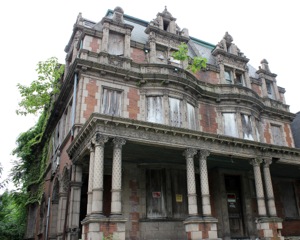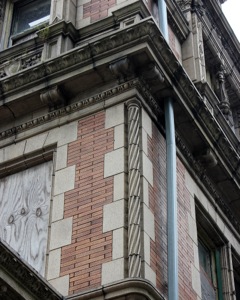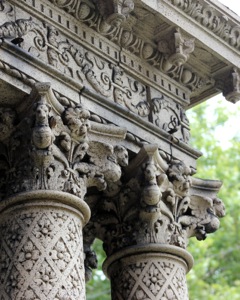The Spotlight Series is an occasional series that highlights interesting people, places, programs, and partner organizations working on historic preservation issues.
At the turn of the last century, the 2200 block of West Tioga Street was a fashionable address for business owners and professionals. Homes were up to 5,800 square feet, housing large families and live-in servants.
Architect Edgar Viguers Seeler designed the gem of the block — an 1898 chateau-style twin at 2224-26 West Tioga – for two families that owned the Conkling-Armstrong Terra Cotta Co. In fact, it was an ornate showpiece for their business: making architectural ornamentation. It featured columns encrusted with floral detail, ornate stringcourses and porch balustrades, all made of terra cotta. Combining his training from the Philadelphia Museum and School of Industrial Art, MIT, and the Ecole de Beaux Arts in Paris, Seeler was able to design ornate structures that spanned multiple aesthetics.
 Today, the homes are still there. But 40 percent of residents in the Nicetown Tioga neighborhood of North Philadelphia live below the poverty line. And the Conkling-Armstrong house is in heartbreaking condition, so dilapidated it will not survive many more winters.
Today, the homes are still there. But 40 percent of residents in the Nicetown Tioga neighborhood of North Philadelphia live below the poverty line. And the Conkling-Armstrong house is in heartbreaking condition, so dilapidated it will not survive many more winters.
Vandals have torn off terracotta details and copper piping and even attempted to pry stained-glass windows out of the walls of the Conkling-Armstrong House. The roof has gaping holes. In one place on the second story, an addition has been removed and the opening covered with plywood.
The owner, Dianna, has invested everything she has to keep up with repairs on the 4,000-plus-square-foot house. Her foster parents purchased it in 1945 and raised many foster children there. Dianna inherited the home in 2000.
 To Dianna, the home is a memory of a joyful childhood. When telling stories about her mother, Dianna’s face glows. The brothers and sisters she grew up with had races up and down the three flights of stairs, helped keep the house tidy, and did their schoolwork together every afternoon. She longs to see the home filled with laughter and love once again.
To Dianna, the home is a memory of a joyful childhood. When telling stories about her mother, Dianna’s face glows. The brothers and sisters she grew up with had races up and down the three flights of stairs, helped keep the house tidy, and did their schoolwork together every afternoon. She longs to see the home filled with laughter and love once again.
As a graduate student in the historic preservation program at University of Pennsylvania I came to know this house and its owner this summer. Dianna’s passion for its rehabilitation is evident. She’s made it her mission to preserve the home – but most of those efforts have gone unrewarded. Her attempts to secure financial help to repair the home have gone nowhere. This neighborhood is not hip, not gentrifying, seemingly not even on the radar of elected officials.
Despite these setbacks, Dianna has never given up. And by the end of my first conversation on Dianna’s front porch on a humid July day, we’d developed plans for a nonprofit group to advocate for the house, started planning a workday to address immediate maintenance issues, and began brainstorming fundraising ideas. You can read more about these efforts at The Conkling-Armstrong House blog.
Its historic value alone makes Dianna’s house worth saving. Ira L. Conkling and Thomas F. Armstrong formed Conkling-Armstrong Terra Cotta Co. in 1895. Their manufacturing plant was about two blocks from where the home is located. With orders from architects such as Daniel Burnham, Horace Trumbauer, and Cope & Stewardson, they quickly rose in prestige among the builders of the era.
 One of the first few terra cotta companies in the nation, Conkling-Armstrong’s terra cotta work can be seen on buildings along the Eastern seaboard. Its work focused on custom orders. The company’s 1898 Portfolio notes that “We do not endeavor to carry any considerable amount of stock work. Owing to the variety of color, size, shape and quantity for the buildings at present, it would be useless to try to anticipate the demand.” Paging through the digitized portfolio offers a glimpse of the fine craftsmanship and intricate detail Conkling-Armstrong was able to deliver to their clients.
One of the first few terra cotta companies in the nation, Conkling-Armstrong’s terra cotta work can be seen on buildings along the Eastern seaboard. Its work focused on custom orders. The company’s 1898 Portfolio notes that “We do not endeavor to carry any considerable amount of stock work. Owing to the variety of color, size, shape and quantity for the buildings at present, it would be useless to try to anticipate the demand.” Paging through the digitized portfolio offers a glimpse of the fine craftsmanship and intricate detail Conkling-Armstrong was able to deliver to their clients.
The three-story home on West Tioga serves as a stunning example of the capabilities of the inexpensive building material. Three elevations are visible from the public right-of-way, each decorated with extensive detail in a wide variety of floral, geometric, and rococo designs.
Philadelphia is full of historic structures in need of attention, and preservation budgets are stretched to their limits. But we can’t let this home slip away from us. We need to tell this neighborhood, through our commitment, that its architectural resources are just as important as those in Center City.
Jennifer Robinson is in her second year of the Graduate Program in Historic Preservation at the University of Pennsylvania’s school of design, with a focus on preservation planning and urban redevelopment. She is currently researching models for effective outreach to communities often underserved by the preservation practice, writing a history of the Conkling-Armstrong Terra Cotta Company, starting a nonprofit organization to support the long-term needs of the house, and coordinating the Penn Preservation Students Association. She was selected by the NAPC as an emerging scholar and invited to speak at the recent conference in Philadelphia.
Looks like Dianna had to give up as the house was sold in June of 2018 for $1000 per property.phila.gov
The blog is also gone
Wow…$1000 per property in 2018!!!!! And I found sales in June 2021 for $100,000 (2024) and $75,000 (2026).